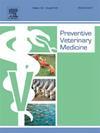Characterizing state-level patterns of interstate certificates of veterinary inspection exceptions across the United States
IF 2.2
2区 农林科学
Q1 VETERINARY SCIENCES
引用次数: 0
Abstract
Interstate Certificates of Veterinary Inspection (ICVIs) are documents widely used in studies to describe animal movements across the United States (US) and subsequently, explore the potential for disease spread. However, unique state-level exceptions to ICVI documentation exist. This project aimed to describe these exceptions in US state regulations and investigate the association between state-level characteristics - such as in-state cattle shipments and number of slaughter operations – and the number of ICVI exceptions. Exceptions were systematically recorded by accessing official sources. These included exceptions 1) for cattle moving directly to slaughter, 2) for cattle moving to a livestock market, 3) allowing the use of other forms of animal identification, 4) allowing the use of commuter permits, 5) allowing the use of grazing permits, 6) for cattle moving directly to veterinary care, 7) for cattle moving to a feedlot, 8) for cattle moving to an approved tagging site, 9) for cattle moving to their origin farm, 10) for cattle being held in quarantine, and 11) for cattle under a certain age. A multivariable Poisson regression model was used to investigate the association between the number (count) of exceptions and cattle-related characteristics at the state level. Statistical significance was determined at p < 0.05. Results revealed that 86 % of states had at least one exception to ICVI usage, with a mean (±SD) 2.5 (±1.6) exceptions per state. Notably, 82 % of states included exceptions for slaughter movements, and half of the states allowed alternative forms of animal identification. The final model showed that states with 17–33 slaughter operations had a significantly higher rate of exceptions (IRR = 2.12; P = 0.06) compared to those with fewer than 17 slaughtering facilities. Findings from this study showed that basing cattle movement networks solely on ICVI documentation may negatively impact disease traceability in cattle, given that the proportion of states using alternative movement documentation was substantial. Additionally, it highlighted the fact that US states with a high potential impact on disease transmission, such as those having high traffic for cattle slaughter purposes, had a higher number of exceptions to ICVI usages. This indicates critical vulnerabilities in the broader network of cattle movement, highlighting the need for more comprehensive approaches to disease traceability and prevention in the US cattle industry.
描述美国州际兽医检验例外证书的州级模式
州际兽医检验证书(ICVIs)是研究中广泛使用的文件,用于描述美国各地的动物运动,并随后探索疾病传播的可能性。但是,对ICVI文件存在独特的州一级例外。本项目旨在描述美国州法规中的这些例外情况,并调查州一级特征(如州内牛运量和屠宰操作数量)与ICVI例外数量之间的关系。通过查阅官方资料系统地记录了例外情况。包括异常1)牛直接移动到屠杀,2)对牛搬到一个牲畜市场,3)允许使用其他形式的动物识别、4)允许使用通勤许可证,5)允许放牧的使用许可,6)对牛直接移动到兽医护理,7)牛搬到饲养场,8)牛搬到一个批准标签网站,9)牛搬到他们的起源农场,10)对牛被关在隔离,11)对一定年龄以下的牛。采用多变量泊松回归模型研究了例外数量(计数)与州一级牛相关特征之间的关系。p < <; 0.05,具有统计学意义。结果显示,86% %的州至少有一个ICVI使用例外,每个州平均(±SD) 2.5(±1.6)个例外。值得注意的是,82% %的州包括屠宰运动的例外情况,一半的州允许其他形式的动物鉴定。最终模型显示,拥有17-33 屠宰操作的州的例外率明显更高(IRR = 2.12;P = 0.06)。这项研究的结果表明,考虑到使用替代运动文件的州的比例很大,仅以ICVI文件为基础的牛运动网络可能会对牛的疾病可追溯性产生负面影响。此外,它还强调了这样一个事实,即对疾病传播具有高度潜在影响的美国各州,例如那些以屠宰牛为目的的交通量很大的州,在使用ICVI方面有更多的例外情况。这表明在更广泛的牛运动网络中存在严重的脆弱性,突出表明美国养牛业需要更全面的疾病可追溯性和预防方法。
本文章由计算机程序翻译,如有差异,请以英文原文为准。
求助全文
约1分钟内获得全文
求助全文
来源期刊

Preventive veterinary medicine
农林科学-兽医学
CiteScore
5.60
自引率
7.70%
发文量
184
审稿时长
3 months
期刊介绍:
Preventive Veterinary Medicine is one of the leading international resources for scientific reports on animal health programs and preventive veterinary medicine. The journal follows the guidelines for standardizing and strengthening the reporting of biomedical research which are available from the CONSORT, MOOSE, PRISMA, REFLECT, STARD, and STROBE statements. The journal focuses on:
Epidemiology of health events relevant to domestic and wild animals;
Economic impacts of epidemic and endemic animal and zoonotic diseases;
Latest methods and approaches in veterinary epidemiology;
Disease and infection control or eradication measures;
The "One Health" concept and the relationships between veterinary medicine, human health, animal-production systems, and the environment;
Development of new techniques in surveillance systems and diagnosis;
Evaluation and control of diseases in animal populations.
 求助内容:
求助内容: 应助结果提醒方式:
应助结果提醒方式:


